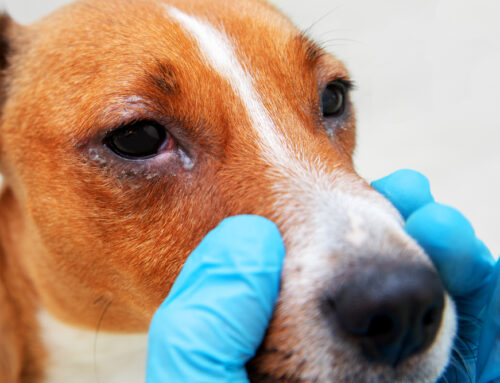April has been designated as Prevent Lyme Disease in Dogs Month, making this the perfect time to discuss how tick-borne illnesses affect your dog’s eyes. Infections such as Lyme disease cause many significant problems for your dog, including ocular abnormalities. Our team at Veterinary Vision Center wants to provide information about how these illnesses affect your dog’s eyes and offer advice to safeguard your pet.
What tick-borne diseases affect dogs?
Numerous tick-borne diseases affect dogs, including Lyme disease, Rocky Mountain spotted fever, and ehrlichiosis. All can cause significant health issues.
- Lyme disease — Lyme disease is a bacterial infection caused by Borrelia burgdorferi, which is transmitted by the bite of an infected black-legged tick. Signs typically include swollen lymph nodes, joint swelling, lethargy, lameness, and decreased appetite. In addition, serious kidney disease has been associated with Lyme disease. Ocular lesions are also common.
- Rocky Mountain spotted fever (RMSF) — RMSF is caused by an intracellular parasite called Rickettsia rickettsii, which is transmitted by the bite of an infected tick. Ticks that carry the disease include the Rocky Mountain wood tick, the American dog tick, and the brown dog tick. RMSF causes inflammation in the small blood vessels throughout the body, leading to damage to multiple organs. Common signs include lethargy, fever, nosebleed, cough, enlarged lymph nodes, and skin necrosis. If the central nervous system is affected, signs can include weakness, lack of coordination, and seizures. Ocular lesions occur secondary to inflammation of the small blood vessels in the eyes.
- Ehrlichiosis — Caused by several different Ehrlichia species, ehrlichiosis is transmitted by the bite of an infected brown dog tick, and illness occurs in three phases.
- Acute — Occurring one to three weeks after a dog is bitten, signs include lethargy, a decreased appetite, and enlarged lymph nodes. During this time, the parasites are replicating and attaching to white blood cell membranes.
- Subclinical — One to four weeks after the acute phase, the parasite sequesters in the spleen. The only signs during this phase are slight abnormalities in blood work.
- Chronic — Some dogs remain in the subclinical phase for the rest of their lives, but some progress to the chronic stage. During this phase, abnormal bleeding may occur, inflammation inside the eye is commonly seen, neurologic abnormalities may appear, and kidney damage may occur.
How do tick-borne illnesses cause eye problems for dogs?
Tick-borne illnesses cause an inflammatory response throughout your dog’s body, and, in some cases, their eyes are affected by this inflammation. The uveal tract, which comprises the iris, ciliary body, and choroid, is the structure in the eye most commonly affected by this inflammatory response. This condition is called anterior uveitis, and signs include squinting, tearing, eye redness, ocular discharge, and sensitivity to light.
How is tick-borne anterior uveitis diagnosed in dogs?
A thorough history, physical examination, and ophthalmic examination are an important start to determine what is causing your dog’s signs. If they have had known exposure to a tick, or if they are exhibiting signs consistent with a particular disease, a tick-borne illness may be suspected. Blood tests are available to help determine if your dog has a tick-borne disease, and other blood work, such as a complete blood count and a biochemistry profile, also may be recommended to evaluate their overall health status. In addition, your dog’s eyes will be evaluated with an ophthalmoscope, and their intraocular pressure (IOP) will be measured because signs of uveitis can be similar to those of glaucoma. The IOP in a uveitic eye is typically lower than normal, whereas the IOP in a glaucomatous eye is higher than normal. If the inflammation in your dog’s eye makes seeing the back of their eye difficult, an ocular ultrasound may be performed to better evaluate their retina.
How is tick-borne anterior uveitis treated in dogs?
Treatment focuses on resolving the inflammation inside the eye, as well as clearing the infection causing the inflammatory process. Most tick-borne illnesses respond well to a specific antibiotic class, and affected pets typically require medication for several weeks or months. The uveitis is addressed by administering topical eye drops and systemic medications to control the inflammation. This therapy often is needed for weeks or months, and, in some cases, a dog may need lifelong management. Frequent examinations also are needed to ensure complications such as glaucoma or retinal detachment do not occur.
How can I prevent tick-borne anterior uveitis in dogs?

You can reduce your dog’s risk of developing tick-borne uveitis by following a few simple tips.
- Year-round tick prevention — Providing year-round tick prevention is the best way to protect your dog.
- Lyme vaccination — A vaccination against Lyme disease is available, and you can talk to your family veterinarian to determine if this is an appropriate option for your dog. This vaccine does not protect your pet against other tick-borne illnesses.
- Maintain your lawn — Ticks prefer tall grass, and keeping your lawn well-maintained can help protect your pet.
- Avoid certain areas — Avoid areas such as tall grasses, marshes, and wooded spots where ticks are most likely to be found.
- Check your dog — After being outside, check your dog thoroughly for ticks. The parasites can be found anywhere, but the most common areas include under their tail, in their ears, between their toes, under their collar, and in their groin region.
Protect your dog’s eyes by taking steps to decrease their exposure to ticks. If your dog is affected by tick-borne uveitis, contact our team at Veterinary Vision Center so we can start treatment to decrease the inflammation and protect their vision.







Leave A Comment